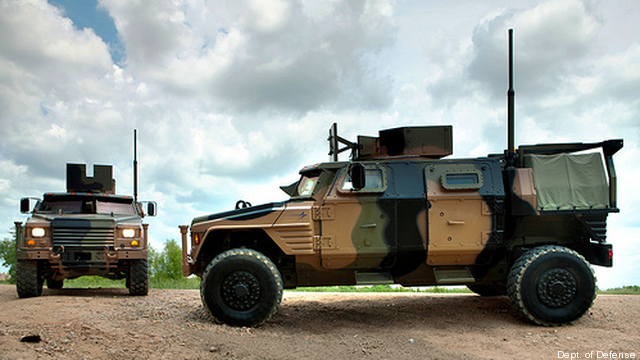 WASHINGTON: Army and Marine Corps efforts to cut costs on the Joint Light Tactical Vehicle may be too little, too late to save the program, according to a new Congressional Research Service report.
WASHINGTON: Army and Marine Corps efforts to cut costs on the Joint Light Tactical Vehicle may be too little, too late to save the program, according to a new Congressional Research Service report.
The initial sticker shock for the JLTV has not faded away from congressional lawmakers minds, despite the services’ cost reduction efforts. Breaking that mentality inside Congress will be difficult and could end up sealing the program’s fate, according to the report. “Given this wide-ranging opposition to the JLTV program on the basis of affordability, even a [cheaper] JLTV variant might prove to be difficult to justify,” CRS analysts write. Last year, legislators scoffed at the vehicle’s initial $350,000 price tag. And they made their feelings known by stripping millions from the program in the fiscal 2012 defense spending legislation.
As a result, the Army and Marines rolled out a new JLTV proposal request last October featuring a drastically shortened development timeline and per unit cost of just over $200,000 per truck. That revised price tag was $150,000 cheaper than initial service estimates. But doubts continue to swirl on Capitol Hill over whether the services can keep that promise, the report states.
Army and Marine Corps officials were able to significantly cut JLTV costs by stripping a number of capabilities from the base version of the truck. Standard armor setups on the JLTV became optional. Advanced command and communication packages slated for the truck were broken down into “scaleable” segments that can be added onto the standard JLTV. Taking these elements out of the JLTV equation got the services where they needed to be on cost.
Thing is, these options — if deemed necessary by service requirements — may be tacked back into the JLTV, the report points out. Once those amenities go back onto the vehicle, those cost savings go out the window. And, most importantly to the Hill, there is nothing lawmakers can do about it once funding is approved. “Given this possibility, Congress might choose to closely monitor the Army and Marines during the rest of [the program] . . . . to ensure that the services do not make significant requirements changes [or] additions that could adversely affect the JLTV development timeline and program cost.”
Despite those concerns, the JLTV continues to have to full backing of top Army and Marine Corps brass. Army Chief of Staff Gen. Ray Odierno and Army Secretary John McHugh have stated repeatedly that JLTV will be the service’s combat truck of the future. Will that be enough to save a program that many claim to be a poster child for Pentagon procurement bloat? Or will the Hill wield their power of the purse and put the JLTV out to pasture once and for all?
Stay tuned.
Questions hang over UK’s new, ambitious defense spending plan: Analysts
Such is the scale of British Army acquisition problems alone that they could not be resolved if the UK moved to a long term spending settlement of even 4 percent GDP, an expert told British lawmakers.


























